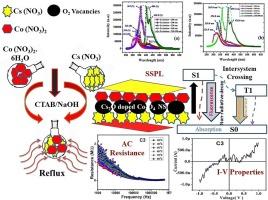Influence of morphology, crystal structures on the enhanced photoluminescence dynamics, zeta potential, and AC resistance of disc shaped cesium oxidex@cobalt oxide nanostructures
Q3 Physics and Astronomy
引用次数: 0
Abstract
In the present study, cesium oxidex@cobalt oxide (Cs2Ox@Co3O4) (x = 5, 10 and 12 wt%) nanostructures (NS) were successfully synthesized by chemical precipitation method and characterized by XRD (X-ray diffraction), SEM (scanning electron microscope), EDX (energy dispersive X-ray), XPS (X-ray photoelectron spectroscopy), BET (Brunauer-Emmett-Teller), Raman, and UV–visible analytical techniques. XRD studies revealed the formation of the mixed phase of orthorhombic/monoclinic crystal structure. Disc shaped morphology of the cesium oxidex@cobalt oxide NS was noticed from SEM images. Redshift in optical absorbance and decrease in optical band gap (Eg) resulted in increase in Cs1+ concentration. Room temperature photoluminescence (RTPL) studies of cesium oxidex@cobalt oxide NS at various excitation wavelengths showed sharp and broad emission peaks located at 668.2 nm (red), 675.1 nm (red), 561.8 nm (yellow-green), 834.5 nm (near infrared region), 594 nm (yellow). Steady state photoluminescence (SSPL) studies revealed a sharp emission peak at ∼ 428.0 nm (violet) with large stoke’s shift (21.1 to 590.0 eV). The zeta potential studies showed a decrease in conductance from 62 to 57 μs with an increase in mobility of the charge carriers (0.4 to 1.08 μ/s V/cm) and an increase in zeta potential (31.90 to 82.92 mV). AC resistance studies at various temperatures showed inducting coupling phenomenon in cesium oxidex@cobalt oxide NS with DC resistance of cesium oxide5 wt.%@cobalt oxide was found to be 8.2 × 10–4 Sm–1. The relaxation frequency of cesium oxide12 wt.%@cobalt oxide NS was found be 1.2 × 105 Hz. The synthesized NS is a promising candidate for optoelectronics and photonic applications.

形态、晶体结构对圆盘形氧化铯@氧化钴纳米结构的增强光致发光动力学、ZETA电位和交流电阻的影响
本研究采用化学沉淀法成功合成了氧化铯@氧化钴(Cs2Ox@Co3O4)(x = 5、10 和 12 wt%)纳米结构(NS),并利用 XRD(X 射线衍射)、SEM(扫描电子显微镜)、EDX(能量色散 X 射线)、XPS(X 射线光电子能谱)、BET(布鲁瑙尔-艾美特-泰勒)、拉曼和紫外-可见分析技术对其进行了表征。X 射线衍射(XRD)研究揭示了正交/单斜晶体结构混合相的形成。扫描电镜图像显示氧化铯@氧化钴 NS 呈圆盘状。随着 Cs1+ 浓度的增加,光学吸光度发生红移,光带隙(Eg)减小。在不同激发波长下对氧化铯@氧化钴 NS 进行的室温光致发光(RTPL)研究显示,在 668.2 nm(红色)、675.1 nm(红色)、561.8 nm(黄绿色)、834.5 nm(近红外区域)和 594 nm(黄色)处有尖锐而宽广的发射峰。稳态光致发光(SSPL)研究显示,在 ∼ 428.0 nm 处有一个尖锐的发射峰(紫色),并有较大的斯托克偏移(21.1 至 590.0 eV)。zeta 电位研究表明,随着电荷载流子迁移率的增加(0.4 至 1.08 μ/s V/cm)和 zeta 电位的增加(31.90 至 82.92 mV),电导率从 62 μs 下降到 57 μs。不同温度下的交流电阻研究表明,氧化铯@氧化钴 NS 中存在感应耦合现象,氧化铯5 wt.%@氧化钴的直流电阻为 8.2 × 10-4 Sm-1。氧化铯 12 wt.%@氧化钴 NS 的弛豫频率为 1.2 × 105 Hz。合成的氧化铯12 wt.%@氧化钴NS有望应用于光电子和光子领域。
本文章由计算机程序翻译,如有差异,请以英文原文为准。
求助全文
约1分钟内获得全文
求助全文
来源期刊

Results in Optics
Physics and Astronomy-Atomic and Molecular Physics, and Optics
CiteScore
2.50
自引率
0.00%
发文量
115
审稿时长
71 days
 求助内容:
求助内容: 应助结果提醒方式:
应助结果提醒方式:


